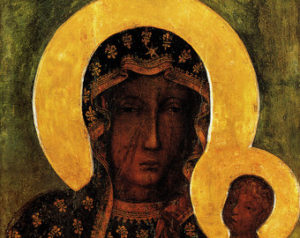 This weekend the Church celebrated the Feast of Our Lady of Czestochowa. This feast commemorates the famous icon of Our Lady that, according to legend, was painted by St. Luke at the house of the Holy Family. The icon ended up in Constantinople due to the efforts of St. Helena, and then was brought to Poland before the fall of Constantinople in the 15th century. The icon became the spiritual heart of the Poles, reminding them of Mary’s maternal care through the hardships of their history. In 1979, shortly after becoming Pope, Saint John Paul II traveled to Poland in what has been remembered as the “Nine Days That Changed the World.” On that trip, he went to Jasna Gora, the home of Our Lady of Czestochowa, and reminded the Poles to consecrate “everything through Mary.” He urged them to give over to Mary’s maternal heart all their sufferings, sacrifices, and hopes. Only in Her, who is rooted in the Son, will they find the liberation they were seeking, the freedom grounded in authentic self-gift that only Christ can give.
This weekend the Church celebrated the Feast of Our Lady of Czestochowa. This feast commemorates the famous icon of Our Lady that, according to legend, was painted by St. Luke at the house of the Holy Family. The icon ended up in Constantinople due to the efforts of St. Helena, and then was brought to Poland before the fall of Constantinople in the 15th century. The icon became the spiritual heart of the Poles, reminding them of Mary’s maternal care through the hardships of their history. In 1979, shortly after becoming Pope, Saint John Paul II traveled to Poland in what has been remembered as the “Nine Days That Changed the World.” On that trip, he went to Jasna Gora, the home of Our Lady of Czestochowa, and reminded the Poles to consecrate “everything through Mary.” He urged them to give over to Mary’s maternal heart all their sufferings, sacrifices, and hopes. Only in Her, who is rooted in the Son, will they find the liberation they were seeking, the freedom grounded in authentic self-gift that only Christ can give.
Poland is a country that not only sees its history through the lens of Providence but a land where it is very common to find people who see their own particular histories through the dynamics of the Faith. Dedication to Mary is part of that. It begins in the home, especially through daily recitation of the Rosary and simple acts of consecration to Mary at a young age. Religious vocations flourish in such a culture because life is interpreted as bring from and for God, encouraging the youth to make Mary’s “fiat” an integral part of their lives. The vow of consecration and the vow of marriage are seen as participations in Mary’s way of life who is both Virgin and Spouse. The Institute on Religious Life has a special devotion to Mary since she is the Mother of Vocations. Each day we should pray through Mary for vocations, and we should look to Our Lady of Czestochowa for help and guidance.